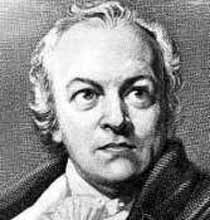William Blake
William Blake

(1757-1827)— "I was angry with my friend; I told my wrath, my wrath did end. I was angry with my foe; I told it not, my wrath did grow." ('A Poison Tree' in Songs of Experience) William Blake, the son of a London hosier, did not receive any formal education but was self-taught in many respects before he enrolled as an apprentice to James Basire who was the engraver for the Society of Antiquities. Following this he studied at the Royal Academy, and made a living from the age of twenty-two onwards as an engraver for Joseph Johnson, a famously radical bookseller who published Mary Wollstonecraft's writing among others'. In 1782 he married Catherine Boucher and their marriage was a lasting and happy one although it produced no children. At this time Blake came under the spell of Macpherson's Ossianic writings and fell into the company of various intellectuals such as Flaxman and the circle of the Reverend A S Mathew. With their aid Blake published his first book of poetry, Poetical Sketches (1783), and set up his own print shop in 1784. From this time onwards Blake took the rather unusual step of engraving rather than printing his works, and doing so himself. He made his own ink, hand-printed the pages, illustrated them himself and got his wife to sew the covers on. This cottage industry produced two of the best loved and original books of poetry of the eighteenth century: namely, Songs of Innocence (1789) and Songs of Experience (1794). Their poems were written in a simple style that made them accessible for children and they show two opposite worlds: one in which God is trusted implicitly and there is no question of moral issues; and one in which the fallen state is examined and religious hypocrisy is examined. They question on a basic level the Enlightenment mode of thinking about Christianity in all its repressive, Puritanical vainglory. These themes continue in Thel which was etched around the time of 1789 and presents them in the words of invented characters who muse upon Blake's radical interpretation of Christianity. Blake's works became increasingly complex with Tiriel (written in 1789 and published in 1874), where the poet first introduces his blind and fiercely repressive father figure that reappears frequently in his later works. In the early 1790s, Blake produced his single important prose work, The Marriage of Heaven and Hell, and a number of revolutionary pieces including America: A Prophecy (1793) and Visions of the Daughters of Albion in the same year. A man touched by, if not madness as is frequently assumed, then at least a visionary instinct, Blake wrote with alleged aid of the spirit world and combined this mystical ecstasy with his radical political fervour. He said to a friend, "I write when commanded by the spirits, and the moment I have written I see the words fly about the room in all directions. It is then published and the spirits can read. My manuscripts are of no further use. I have been tempted to burn my manuscripts, but my wife won't let me". Blake continued to write in Lambeth after 1790 without much acclaim, producing after Songs of Experience (with its well-known verse "Tyger! Tyger! burning bright") various works including The Book of Urizen (1794), The Song of Los (1795) and The Four Zoas (also known as Vala, written and revised 1797-1804). Most important though was his poem in two books called Milton that was written and etched between 1804 and 1808. It is sometimes near impenetrable but contains the extremely famous lines known as 'Jerusalem' beginning, "And did those feet in ancient time". The poem revolves around Blake's continued obsession and fascination with Milton's Paradise Lost. One story tells of Blake and his wife reading passages from Milton's poem naked and aloud in their garden unfazed by the arrival of a friend. The later years of the great poet and engraver were darkened by his lack of success and by various poor deals such as that for drawings to accompany Robert Blair's The Grave that Robert Cromek refused to pay him for. He was lost in obscurity, alienating even his circle of friends. Despite his hard work he languished without an appreciative audience, still producing fine poetry such as "The Everlasting Gospel" in 1818. He died in 1827 but interest in his life and works only began after Gilchrist's biography of 1863 and other poets' realisation of his uniquely intelligent and complex prophetic vision of existence and religion so misunderstood in his time.Introduction


























